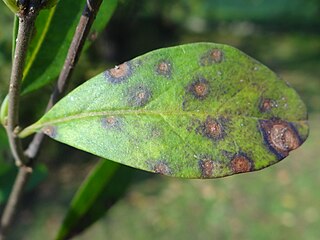
Eurotiomycetes is a large class of ascomycetes with cleistothecial ascocarps within the subphylum Pezizomycotina, currently containing around 3810 species according to the Catalogue of Life. It is the third largest lichenized class, with more than 1200 lichen species that are mostly bitunicate in the formation of asci. It contains most of the fungi previously known morphologically as "Plectomycetes".

Sarocladium oryzae (Sawada) is a plant pathogen causing the Sheath rot disease of rice and Bamboo blight of Bambusoideae spp. in Asia.

The Mycosphaerellaceae are a family of sac fungi. They affect many common plants, such as eucalyptus, the myrtle family, and the Proteaceae. They have a widespread distribution.

The Coryneliales are an order of ascomycetous fungi within the monotypic subclass Coryneliomycetidae in the class Eurotiomycetes and within the subdivision Pezizomycotina. Species in this order are found almost exclusively in the tropics, primarily as a pathogen on the gymnosperm Podocarpus, although it has been found on other plants like the Southern Hemisphere beech Nothofagus, and Drimys.

Teratosphaeriaceae is a family of fungi in the order Mycosphaerellales.
Penicillium coccotrypicola is a fungus species of the genus of Penicillium.

The Coniochaeta are a genus of pleomorphic yeasts of the order Coniochaetales and are pathogens of trees. Some species have also been found to form endophytic associations within plants in which they live inside plant tissues but do not actually harm the organism. They can take the form of pink to brown colonies, hyphae, conidiophores or sclerotia. In 2013, the Lecythophora were merged with the Coniochaeta, following suggestions by Ziauddin Khan et al.
Chrysosporium longisporum is a keratinophilic microfungus in the family Onygenaceae that causes skin infections in reptiles, producing hyaline, thin-walled, small, sessile conidia and colonies with a strong skunk-like odour.
Nannizziopsis pluriseptata is a keratinophilic microfungus in the family Onygenaceae that causes skin infections in reptiles, producing hyaline, thin-walled, small, sessile conidia and colonies with a strong skunk-like odour. It is distinguished by its production of 1- to 5-celled sessile conidia.
Nannizziopsis arthrosporioides is a keratinophilic microfungus in the family Onygenaceae that causes skin infections in reptiles, producing hyaline, thin-walled, small, sessile conidia and colonies with a strong skunk-like odour. It is distinguished by the production of long arthroconidia.
Nannizziopsis draconii is a keratinophilic microfungus in the family Onygenaceae that causes skin infections in reptiles, producing hyaline, thin-walled, small, sessile conidia and colonies with a strong skunk-like odour.
Nannizziopsis chlamydospora is a keratinophilic microfungus in the family Onygenaceae that causes skin infections in reptiles, producing hyaline, thin-walled, small, sessile conidia and colonies with a strong skunk-like odour. This species is distinguished by producing chlamydospores and its ability to grow at 5 °C.

The Stachybotryaceae are a family of fungi in the order Hypocreales; the genera it contains have been described as "hyper-diverse".
Arthrographis is a genus of fungi that are widespread in the environment and occasionally cause infection in animals. Arthrographis species have been found worldwide in samples from air, compost, marine sediment, soil, wood, and human infection.

Xenodevriesia strelitziicola is a pathogenic ascomycete fungus in the class Dothideomycetes that infects the South African plant Strelitzia. It is the only species of the monotypic genus Xenodevriesia and family Xenodevriesiaceae.

Thedgonia is a genus of fungi in the family Drepanopezizaceae of the order Helotiales. They have been recorded in most places in Europe including Great Britain.
Conioscypha is a genus of terrestrial and freshwater fungi in the monotypic family Conioscyphaceae and the monotypic order Conioscyphales. They are found on decayed wood, leaves, or bamboo stems. Except for Conioscypha japonica which was isolated from dog skin fragments and hair in 2017.
Pararamichloridium is a genus of fungi in the monotypic family Pararamichloridiaceae and within the monotypic order of Pararamichloridiales and also in the subclass Hypocreomycetidae. They are saprobic on wood in terrestrial and freshwater habitats.

Coniothyriaceae is a family of ascomycetous marine based fungi within the order of Pleosporales in the subclass Pleosporomycetidae and within the class Dothideomycetes. They are pathogenic or they can be saprobic on dead branches. They are generally a anamorphic species.

Neocamarosporium is a genus of ascomycete fungi, as accepted by Wijayawardene et al. 2020. The species are typically halotolerant, being commonly found in saline environments like in saline water, hypersaline soils and especially in association with halophytes.










